AUCTORES
Globalize your Research
Research Article | DOI: https://doi.org/10.31579/2767-7370/094
Department of Pathology, Faculty of Veterinary Medicine University of Khartoum
*Corresponding Author: Elmahi Bilal Abdelsalam. Department of Pathology, Faculty of Veterinary Medicine, University of Khartoum. The republic of Sudan.
Citation: Ramli Elzebair RA and Elmahi B. Abdelsalam, (2024), Toxicological Evaluation of the Ethanolic Extract the Tropical Medicinal Plant Ximenia americana in Albino Wistar Rats, J New Medical Innovations and Research, 5(3); DOI:10.31579/2767-7370/094
Copyright: © 2024, Elmahi Bilal Abdelsalam. This is an open access article distributed under the Creative Commons Attribution License, which permits unrestricted use, distribution, and reproduction in any medium, provided the original work is properly cited.
Received: 16 March 2024 | Accepted: 25 March 2024 | Published: 01 April 2024
Keywords: traditional (folk) medicine; medicinal plants; ximenia americana; sudan
The present work comprises a preliminary phytochemical analysis and toxicological evaluation of the ethanolic extract of the dry leaves of the tropical medicinal plant Ximenia americana in albino Wistar rats. The results of the phytochemical analysis revealed the presence of tannins, flavonoids, saponins, sterols, triterpenes and alkaloids. The repeated oral administration of the ethanolic extract at dose rates of 100, 200 and 400 mg / kg body weight did not produce detectable clinical changes or significant gross or histopathological alterations in experimental rats when the extract was daily given for three weeks. There were no significant changes in hematological parameters including Hb concentration, PCV, RBCs count, MCH, MCHC and PLT count when the ethanolic extract was given at 100 and 200mg /kg body weight. However, a significant increase in RBCs count and other red blood indices was observed when the extract was given at 400 mg/kg body weight. In addition, the plasma biochemical parameters including total plasma protein, albumin, urea nitrogen, creatinine and the plasma enzyme activity of aspartate aminotransferase (AST) and alanine aminotransferase were not significantly affected in experimental rats receiving the ethanolic extract at 100, 200 and 400 mg /kg body weight. The mean body weight was significantly increased in experimental rats receiving 100 mg/kg body weight of the ethanolic extract for three weeks. However, a decrease in mean body weight was observed when the extract was given at 400 mg/kg. It is concluded that the tropical medicinal plant X.americana has an almost negligible adverse effect on rats and therefore could safely be used in folk medicine for treatment of various type of infectious and neoplastic diseases.
The therapeutic potential of numerous types of herbal plants has long been recognized in various countries throughout the ancient and recent history [1]. The type of plant species especially used for treatment of diseases in man and animals are customary designated as medicinal plants. Medicinal plants are widely used in folk or traditional (alternative) medicine for treatment of different types of infectious and neoplastic diseases in human patients particularly in rural areas mainly in developing countries in Africa, Asia and Latin America [2,3]. Nevertheless, the traditional use of medicinal plants has further expanded to include a number of developed countries such as the United Kingdom and many other countries in Europe, North America and Australia [4, 5]. It has been estimated that more than 80% of the total world’s population still depends on herbal medicine for treatment of several types of diseases in different parts of the world [1].
The tropical plant Ximenia americana belongs to the family Olacaceae. It is a short shrub or small tree originally native in Southern America with a wide spread in Africa and many other continents. It is one of the most widely used medicinal plant as a traditional herbal remedy for various types of ailments in numerous countries all over the world. It is extensively used in Nigeria among the Hausa/Fulani communities for treatment of several diseases including malaria, leprotic ulcers and skin infections [6]. It is also used in folk medicine in many other West African countries such as Senegal, Guinea and Burkina Faso to treat various disorders such as oral diseases, inflammation, pain and fever [7-9]. The plant was also used for treatment of sleeping sickness in humans [10, 11] diarrhea and wounds [12] and intoxications [13]. The preparations of the branched leaf, bark, and root were used for treatment of headache, toothache, mumps and conjunctivitis [8,14]. The extract of the plant was also found to have an antimicrobial effect against many microbial organisms including Escherichia coli, Pseudomonas aeruginosa, Candida albicans, Staphylococcus aureus, Klebsiella pneumoniae and so many other bacterial and fungal organisms [6, 9, 12, 15-17].
The traditional use of X. americana as a herbal remedy in Sudan is commonly practiced by rural inhabitants in South Kordofan State and some other areas of Western parts of the country [18,19, 20, 21]. However, very little is currently known about the adverse effect of the plant on human patients and experimental animals. The present investigation was therefore designed to perform a preliminary phytochemical screening and toxicological evaluation of the plant in albino Wistar rats given repeated daily oral doses of the ethanolic extract of the dry leaves for a three-week period of observation (sub-chronic toxicity).
Materials and Methods
Collection of plant material
Ximenia americana leaves were collected from natural forests in North Kordofan State, Sudan. The leaves were identified and authenticated by the scientific staff of the Medicinal and Aromatic Plants Research Institute - National Center of Research, Khartoum, Sudan. The leaves were cleaned and shade dried at room temperature Preparation of Ethanolic Extract. The dry leaves of X.americana were thoroughly grounded using a pestle and mortar. About 220 gm of the powdered leaves were extracted by soaking in 70 % ethanol for seventy two hours with daily filtration and evaporation [22]. Solvent was evaporated under reduced pressure to dryness using rotary evaporator apparatus. The yield of the extract was calculated as follows:
Weight of extract / Weight of sample X 100
The residue obtained was kept in dry clean bottle until used.
Phytochemical Screening
Preliminary phytochemical screening for the active constituents of the plant was carried out on the ethanolic extract using the methods described by Tease and Evans [23].
Experimental Animals
Twenty-four albino Wistar rats weighting between 82-135gm were obtained from the Experimental Animal Unit at the Faculty of Veterinary Medicine, University of Khartoum. They were housed in well-ventilated room with free access to water and food. They were given a seven-day period of adaptation to laboratory environment.
Experimental Design
The experimental rats were divided to four equal groups (n=6). Group 1 rats were kept as undosed controls. The ethanolic extract of X. americana was dissolved in distilled water and administered to the experimental groups as daily repeated oral doses of 100 mg/kg body weight /day (Group2), 200 mg/kg body weight/ day (Group 3) and 400 mg/kg body weight/ day (Group 4). The daily dosing of the extract continued via a stomach tube for a period of three weeks (sub-chronic). (Group2), 200 mg/kg body weight/ day (Group 3) and 400 mg/kg body weight/ day (Group 4). The daily dosing of the extract continued via a stomach tube for a period of three weeks (sub-chronic)
Clinical Observations and Laboratory Analysis
The rats were thoroughly observed for abnormal clinical changes throughout the experimental period (21 days). The body weight of rats was measured before dosing and at weekly intervals. Heparinized blood samples were collected by puncturing retro-orbital plexus using a capillary tube at day zero and day 21. The blood samples were immediately analyzed for hematological parameters including hemoglobin concentration (Hb), packed cell volume (PCV), red blood cell count (RBCs), white blood cell count (WBCs), mean corpuscular volume (MCV), mean corpuscular hemoglobin (MCH) and mean corpuscular hemoglobin concentration (MCHC) by the use of Sysmex Automated Hematology Analyzer (KX-21N, Spain). Plasma was separated by centrifugation of blood at 2500 rpm for 15 minutes and stored at -20°C until analyzed for biochemical parameters including plasma total protein [24], albumin [25], urea (26) and creatinine [27] by using commercial kits (Randox Laboratories Limited UK). The plasma enzyme activity of aspartate aminotransferase (AST) and alanine aminotransferase (ALT) was also measured by commercial kits (BioSystem SA Spain) according to the method of Reitman and Frankel [28]. Control and experimental rats were sacrificed on day 21 for detailed post –mortem examination. The whole carcasses and visceral organs were thoroughly examined for detectable gross lesions. Representative specimens of the liver, kidney, heart, intestine and spleen were fixed in 10% formal saline for routine histopathological processing and staining with haematoxylin and eosin (H&E) as described by Bancroft and Gamble [29].
The results were analyzed using SPSS (Microsoft ver. 20, USA). Data was analyzed using multivariate analysis. The Significance of differences among the group were assessed using T-test. The data were expressed as mean ± standard deviation (STD). Level of significance was taken at (P ˂ 0.05).
Plant Extraction
The results of ethanolic extraction of the dry leaves of X. americana is shown in Table 1. A total of 220 gm of the leaves produced 62.546 gm of ethanolic extract. The yield percentage was 28.43 %.
| Sample | Weight of sample | Weight of extract | Yield % |
| X. americana Leaves | 220 gm | 62.546 gm | 28.43 % |
Table 1: Final yield of ethanolic extract of X. americana dry leave
Phytochemical Analysis
Preliminary photochemical analysis of the ethanolic extract of the dry leaves of X. americana is shown in Table 2. The results revealed the presence of high, amounts of tannins and flavonoids, moderate amounts of saponins, sterols and triterpenes and lesser amounts of alkaloids. Other ingredients reported in literature such as cumarins, anthraquinone glycosides and cyanogenic glycosides were not detected in the ethanolic extract of X. americana leaves in the present stud
Constituent | *Result | Observations |
| Saponins | ++ | Foam |
| Alkaloids | + | Turbidity |
| Tannins | +++ | Green black color + turbidity |
| Flavonoids | +++ | Yellow color + creamy precipitates |
| Sterols | ++ | Green color |
| Triterpenes | ++ | Purple color |
| Cumarins | - | Not detectable |
| Anthraquinone glycosides | - | Not detectable |
| Cyanogenic glycosides | - | Not detectable |
* trace (+) moderate (++) high (+++)
Table 2. Basic phytochemical constituents of ethanolic extract of X. americana leaves (preliminary analysis)
Clinical Findings
No significant abnormal clinical changes were observed in control rats (Group 1) and in other experimental rats receiving repeated daily oral doses of the ethanolic extract of the dry leaves of X. americana at dose rates of 100 mg /kg body weight/day (Group 2), 200 mg /kg body weight /day (Group 3) and 400 mg/kg body weight/ day (Group 4) throughout the observation period (21 days).
Hematological Findings
The effect of administration of the ethanolic extract of X. americana leaves on some hematological parameters of experimental rats is shown in Table 3.
Group 1 (Control) | Group 2 (100 mg/kg/day) | Group3 (200 mg/kg/day) | Group 4 (400 mg/kg/day) | |
| Hb (g/dL) | 13.7±0.64 | 14.6±0.29 | 14.9±0.35 | 18.3±0.45 * |
RBCs (106 L) L) | 7.1±0.62 | 7.5±0.24 | 7.8±0.27 | 9.8±0.35 * |
| PCV (%) | 40.2±1.7 | 43.3±1.1 | 44.8±1.3 | 57.5±1.5 * |
| MCV (fL) | 58.8±1.4 | 58.1±0.75 | 57.8±0.40 | 58.9±0.74 |
| MCH (pg) | 19.5±1.2 | 19.6±0.24 | 19.2±0.22 | 18.8±0.26 |
| MCHC (g/dL) | 33.3±1.7 | 33.9±0.34 | 33.2±0.23 | 31.9±0.20 |
PLT (103 L) L) | 650.5±83.2 | 789.7±53.1 | 813.7±103.2 | 903.6±77.1* |
WBCs(103 L) L) | 9.0±1.4 | 9.1±1.1 | 9.4±10 | 6.1± 0.46* |
Expressed as means ± STD * - significantly different from control (P˂ 0.05)
Table 3: The effect of repeated oral administration of the ethanolic extract of X. americana leaves for three weeks on some hematological parameters of experimental rats
There were no significant changes in the values of hemoglobin (Hb) concentration, red blood cell (RBCs) count and packed cell volume (PCV) in rats receiving 100 mg/kg (Group 2) and 200 mg/kg (Group 3) as compared to control rats (Group 1). However, there was a significant (P ˂ 0.05) increase in these three hematological parameters (Hb, PCV and RBCs count) in Group 4 rats which received 400mg/Kg of the ethanolic extract. No significant changes in the values of red blood indices including mean corpuscular volume (MCV), mean corpuscular hemoglobin (MCH) and mean corpuscular hemoglobin concentration (MCHC) in all treated groups as compared to control. However, a significant (P˂0.05) increase in platelet (PLT) count was further observed in Group 4 rats receiving 400mg/kg of ethanolic extract. A significant decrease in the white blood cell count (WBCs) was, on the other hand observed in Group 4 rats as compared to control.
Plasma Biochemical Findings:
No significant changes were observed in the mean values of total plasma protein, albumin, urea nitrogen, creatinine and the plasma enzyme activity of aspartate aminotransferase (AST) and alanine aminotransferase in experimental rats receiving repeated daily oral doses of the ethanolic extract of X. americana leaves at dose rates of 100 mg/kg body weight /day ( Group 2), 200 mg/kg body weight /day (Group 3) and 400 mg/kg body weight / day ( Group 4 ) for three weeks as compared to control group ( Figures 1-6).
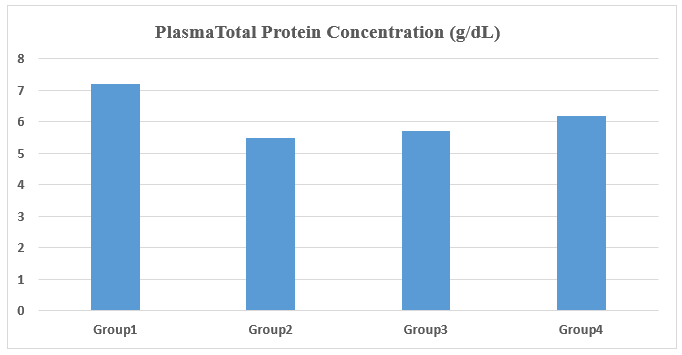
Figure 1. Plasma total protein concentration (g/dL) in control rats (Group1) and experimental rats administrated ethanolic extract of X. americana leaves at dose rates of 100 mg/kg/day (Group2), 200mg/kg/ day (Group3) and 400mg/kg/day (Group 4) for three weeks.

Figure 2. Plasma albumin concentration (g/dL) in control rats (Group1) and experimental rats administrated ethanolic extract of X.americana leaves at dose rates of 100 mg/kg/day (Group2), 200 mg/kg/ day (Group 3) and 400 mg/kg/day (Group 4) for three weeks
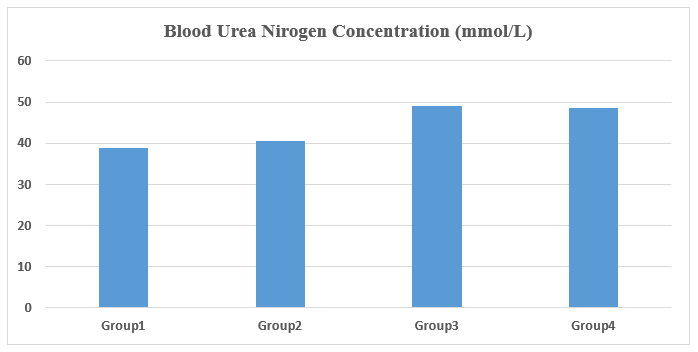
Figure 3. Blood urea nitrogen concentration (mmol/L) in control rats (Group1) and experimental rats administrated ethanolic extract of X. americana leaves at dose rates of 100 mg/kg/day (Group2), 200 mg/kg/ day (Group3) and 400 mg/kg/day (Group 4) for three weeks.
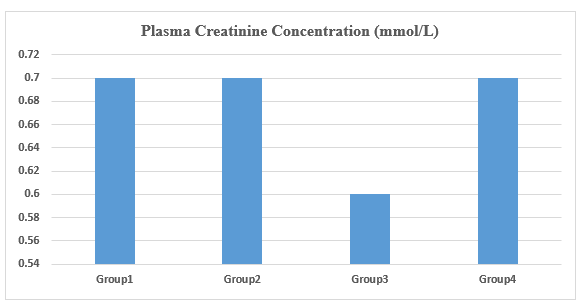
Figure 4. Plasma creatinine concentration (mmol/L) in control rats (Group1) and experimental rats administrated ethanolic extract of X. americana leaves at dose rates of 100 mg/kg/day (Group1), 200 mg/kg day (Group2) and 400 mg/kg/day (Group3) for three weeks
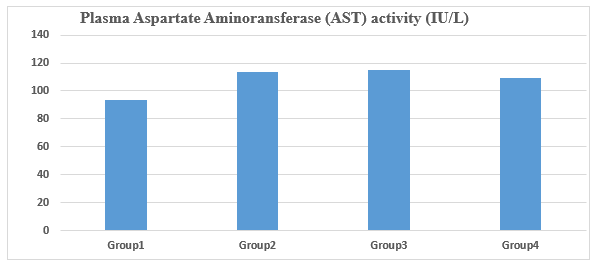
Figure 5. Plasma aspartate aminotransferase activity (IU/L) in control rats (Group1) and experimental rats administrated ethanolic extract of X. americana leaves at dose rates of 100 mg/kg/day (Group2), 200 mg/kg day (Group3) and 400 mg/kg/day (Group4) for three weeks
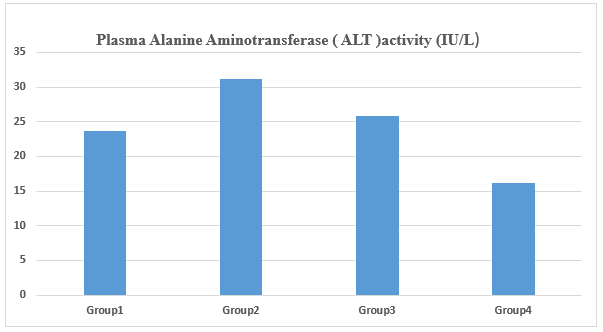
Figure 6. Plasma alanine aminotransferase activity (IU/L) in control rats (Group1) and experimental rats administrated ethanolic extract of X. Americana leaves at dose rates of 100 mg/kg/day (Group2), 200 mg/kg/ day (Group 3) and 400 mg/kg/day (Group 4) for three weeks.
No grossly detectable pathological lesions were observed in the body or in various visceral organs of control rats (Group 1) and in all experimental rats given repeated daily oral doses of the ethanolic extract of X. americana leaves for three weeks at dose rates of 100 mg/kg body weight (Group 2), 200 mg/kg body weight (Group 3) and 400 mg/kg body weight (Group 4). Also, no significant histopathological alterations were observed in the liver, kidney, heart, spleen and intestines of control and experimental groups. Figures 7, 8, 9. 10 and 11 show the absence of histopathological alterations in the liver, kidney, heart, spleen and intestines of Group 4 rats which received the highest dose (400 mg/kg/ day) of the ethanolic extract for three weeks.
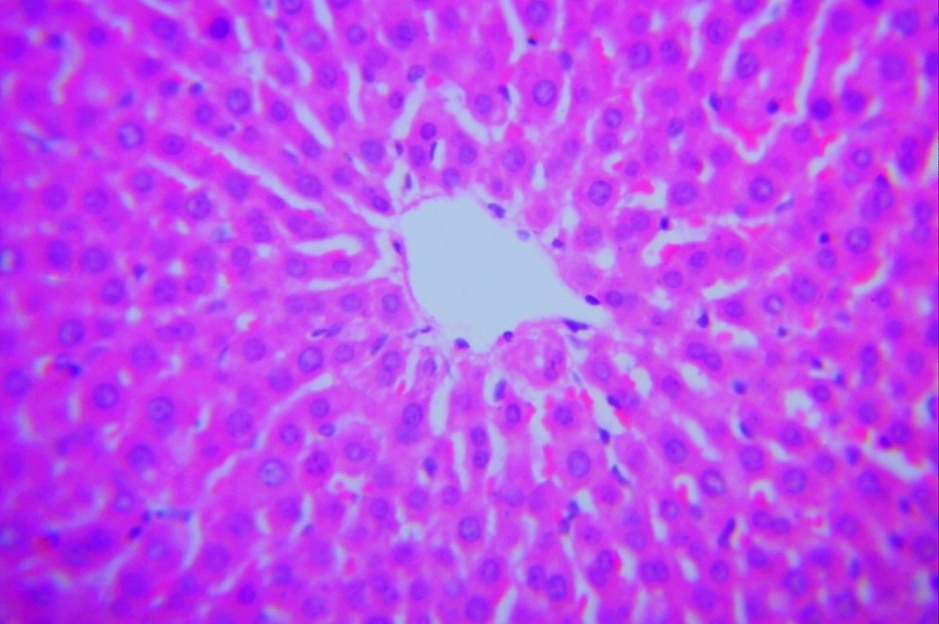
Figure 7: Liver of Group 4 rats receiving 400 mg/kg/day ethanolic extract of X. americana leaves for three weeks. No significant histopathological changes were observed (H&E X400)
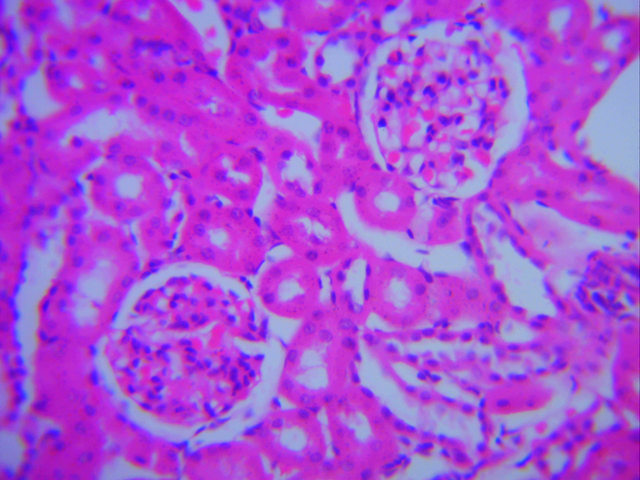
Figure 8. Kidney of Group 4 rats receiving 400 mg/kg/day ethanolic extract of X. americana leaves for three weeks. No significant histopathological changes were observed (H&E X400)

Figure 9. Heart of Group 4 rats receiving 400 mg/kg/day ethanolic extract of X. americana leaves for three weeks. No significant histopathological changes were observed (H&E X400)
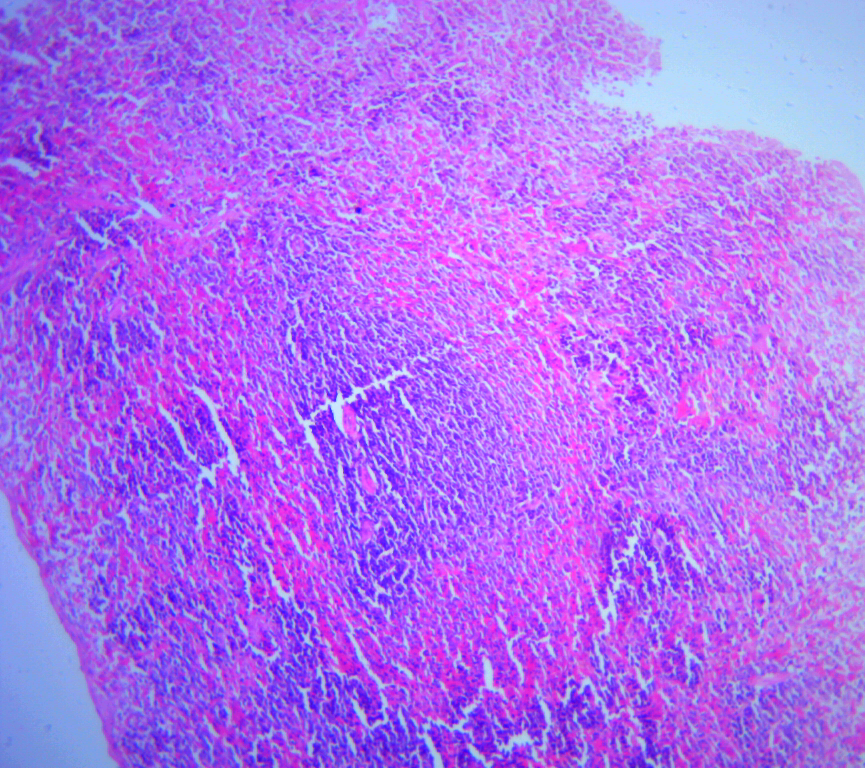
Figure 10. Spleen of Group 4 rats receiving 400 mg/kg/day ethanolic extract of X.americana leaves for three weeks. No significant histopathological changes were observed (H&E X100)
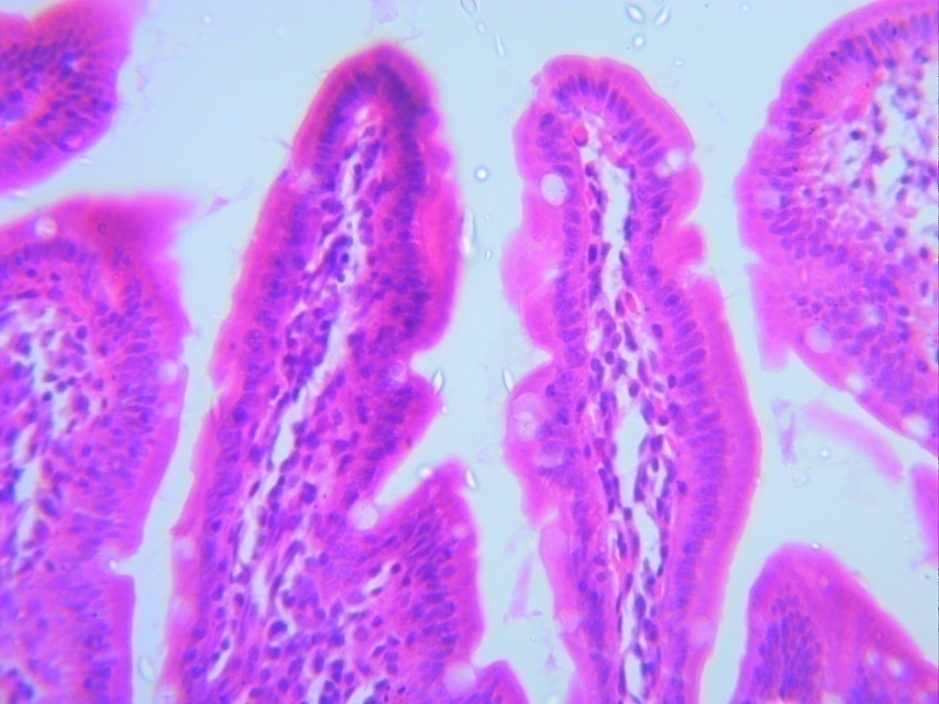
Figure 11. Small intestine of Group 4 rats receiving 400 mg/kg/day ethanolic extract of X.americana leaves for three weeks. No significant histopathological changes were observed (H&E X400)
Body Weight
The mean body weight of control and experimental rats receiving daily repeated oral doses of the ethanolic extract of X. Americana leaves for three weeks is shown in Figure 12.
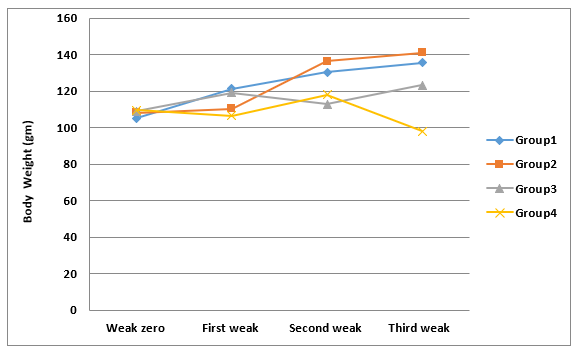
Figure 12: Mean body weight of control rats (Group 1) and experimental rats administered ethanolic extract of X. americana leaves at dose rates of 100 mg/kg/day (Group 2), 200 mg/kg/day (Group 3) and 400 mg/kg/day (Group 4) for three weeks.
There was a significant (P˂0.05) increase in the mean body weight of experimental rats receiving 100 mg/kg/day (Group 2) by the end of the third week as compared to control rats (Group 1). No significant changes were observed in the mean body weight of experimental rats receiving 200 mg/kg/day (Group 3). However, a significant (P˂0.05) decrease in the mean body weight was observed in experimental rats receiving 400 mg/kg/day (Group 4) by the end of the third week as compared to control rats.
The results of the preliminary phytochemical analysis of the ethanolic extract of the dry leaves of X. americana in the present study revealed the presence of several biologically active ingredients including saponins, alkaloids, tannins, flavonoids, sterols and triterpenes. These biologically active ingredients have consistently been detected in aqueous, methanolic and ethanolic extracts of the stem bark, leaves and the root of the plant. [11,13,17,21,30]. It is well established that the beneficial pharmacological properties of the crude plant such as the analgesic, anti-inflammatory, antimicrobial, anticancer and antioxidant effects are mainly attributed to the presence of these biologically active ingredients [17, 21, 31].
The results of the toxicological evaluation of the plant revealed that the repeated daily oral administration of the ethanolic extract of the dry leaves of X. americana at dose rates of 100 mg, 200 mg and 400 mg /Kg body weight /day did not produce any adverse clinical effects on experimental rats when given for a period of three weeks. Similar studies have also demonstrated the absence of lethal or serious clinical effects on mice given the methanolic extract of the plant at single oral doses of 10, 100 and 1000 mg/Kg body weight [32]. Also, the repeated administration of the methanolic extract of the stem bark of the plant did not produce adverse clinical changes in rats when the extract was given orally at dose rates of 250, 500 and 1000 mg/Kg body weight [33]. The results of the present work and the above mentioned reports therefore provide a good evidence of the wide margin of safety of the ethanolic extract of the dry leaves of X.americana.
The results of the present investigation also showed that the repeated administration of the ethanolic extract of the dry leaves of X.americana did not produce significant adverse effects on some hematological parameters including hemoglobin (Hb) concentration, red blood cell (RBCs) count, platelet count (PLT), packed cell volume ( PCV), mean corpuscular volume (MCV), mean corpuscular (MCH) and mean corpuscular hemoglobin concentration (MCHC) in experimental rats when given as daily repeated oral doses of 100 and 200 mg/Kg body weight/ day for three weeks. These results are in agreement with previous findings indicating the absence of adverse effect of the methanolic or ethanolic extract of the stem bark or the dry leaves of X.americana on the major biochemical and hematological parameters of rats and mice [34,35]. On the other hand, a significant increase in Hb concentration, RBCs count, PCV, and PLT count was observed when the ethanolic extract was given at a dose level of 400 mg/Kg body weight. The increase in total erythrocyte count (RBCs) was probably due to an apparently stimulatory effect of the ethanolic extract of the dry leaves of X.americana on the hematopoietic function of the experimental rats. The possible stimulatory effect of X.americana on hematopoietic function explains the high efficacy of the plant in treatment of anemia associated with infectious diseases such as malaria and heavy parasitic infestation in human patients [36].
In the present investigation, the daily repeated oral administration of the ethanolic extract of the dry leaves of X.americana at dose rates of 100, 200 and 400 mg /Kg body weight for a period of three weeks did not produce significant effects in the plasma concentration of total protein, albumin, urea, creatinine and plasma activity of aspartate aminotransferase (AST) and alanine aminotransferase (ALT) in experimental rats. The lack of significant effect on those previously mentioned parameters demonstrates the negligible adverse effect of the plant on the liver and kidney structure and function. These findings are in agreement with those previously reported by Agyigra et al [33]. However, a contradicting report by Wurochekke et al [37] has, on the other hand, revealed a significant increase in the plasma AST activity with a significant reduction in the plasma protein concentration in albino rats receiving a total of 30 repeated oral doses of 240 mg /Kg body weight of the aqueous extract of the stem bark of X.americana. Further studies are therefore required to establish the precise effect of the plant on the liver and kidney function at different dose levels.
The results of the present investigation showed no significant gross or histopathological changes in the liver, kidney, heart, spleen and intestines of experimental groups of rats given repeated daily oral doses of 100, 200 and 400 mg /Kg body weight of the ethanolic extract of the dry leaves of X. americana for three weeks. The absence of significant histopathological changes in these organs is well correlated with the normal values of AST and ALT activity, total plasma protein, albumin, blood urea nitrogen and plasma creatinine concentration. The present results are therefore in agreement with previous findings indicating the relative safety of the plant with respect to an anticipated hepatorenal injury [32, 33].
Evaluation of the effect of the ethanolic extract of the dry leaves of X.americana on body weight performance showed a significant increase in the mean body weight of experimental rats receiving 100 mg/kg/day by the end of the third week. No significant changes were observed in the mean body weight of experimental rats receiving 200 mg/kg/day. The increase in the mean body weight of experimental rats receiving 100 mg/kg/day of the ethanolic extract was probably due to a stimulatory effect of the plant on the animal appetite and to the possible eradication of co-existing internal parasites by the repeated administration of the ethanolic extract of the plant. However, a significant decrease in the mean body weight of experimental rats was, on the other hand, observed when the ethanolic extract was given at 400 mg/Kg body weight. The reduction of the mean body weight of experimental rats receiving the higher dose of the ethanolic extract of the plant was probably due to the presence of tannins which were found to interfere with the gastrointestinal absorption of nutrients [38].
It is concluded from the present results that the tropical medicinal plant X.americana has an almost negligible adverse effect on rats when given as daily repeated doses up 400 mg/kg body weight /day for three weeks. The plant could therefore be safely used in folk medicine for treatment of various type of infectious and neoplastic diseases.
This research was supported by the Graduate College, University of Khartoum. We are grateful to the scientific staff of the Medicinal and Aromatic Plants Research Institute - National Center of Research, Khartoum for identification of the plant and preparation of the ethanolic extract. The technical assistance of Mr. Yassin Jubara in histopathology is also appreciated.
Compliance with ethical standards
All procedures performed in the present investigation were in accordance with the ethical standards of the international and national guidelines for the care and use of animals.
Conflict of interest
The authors declare that they have no conflict of interest.
Clearly Auctoresonline and particularly Psychology and Mental Health Care Journal is dedicated to improving health care services for individuals and populations. The editorial boards' ability to efficiently recognize and share the global importance of health literacy with a variety of stakeholders. Auctoresonline publishing platform can be used to facilitate of optimal client-based services and should be added to health care professionals' repertoire of evidence-based health care resources.

Journal of Clinical Cardiology and Cardiovascular Intervention The submission and review process was adequate. However I think that the publication total value should have been enlightened in early fases. Thank you for all.

Journal of Women Health Care and Issues By the present mail, I want to say thank to you and tour colleagues for facilitating my published article. Specially thank you for the peer review process, support from the editorial office. I appreciate positively the quality of your journal.
Journal of Clinical Research and Reports I would be very delighted to submit my testimonial regarding the reviewer board and the editorial office. The reviewer board were accurate and helpful regarding any modifications for my manuscript. And the editorial office were very helpful and supportive in contacting and monitoring with any update and offering help. It was my pleasure to contribute with your promising Journal and I am looking forward for more collaboration.

We would like to thank the Journal of Thoracic Disease and Cardiothoracic Surgery because of the services they provided us for our articles. The peer-review process was done in a very excellent time manner, and the opinions of the reviewers helped us to improve our manuscript further. The editorial office had an outstanding correspondence with us and guided us in many ways. During a hard time of the pandemic that is affecting every one of us tremendously, the editorial office helped us make everything easier for publishing scientific work. Hope for a more scientific relationship with your Journal.

The peer-review process which consisted high quality queries on the paper. I did answer six reviewers’ questions and comments before the paper was accepted. The support from the editorial office is excellent.

Journal of Neuroscience and Neurological Surgery. I had the experience of publishing a research article recently. The whole process was simple from submission to publication. The reviewers made specific and valuable recommendations and corrections that improved the quality of my publication. I strongly recommend this Journal.

Dr. Katarzyna Byczkowska My testimonial covering: "The peer review process is quick and effective. The support from the editorial office is very professional and friendly. Quality of the Clinical Cardiology and Cardiovascular Interventions is scientific and publishes ground-breaking research on cardiology that is useful for other professionals in the field.

Thank you most sincerely, with regard to the support you have given in relation to the reviewing process and the processing of my article entitled "Large Cell Neuroendocrine Carcinoma of The Prostate Gland: A Review and Update" for publication in your esteemed Journal, Journal of Cancer Research and Cellular Therapeutics". The editorial team has been very supportive.

Testimony of Journal of Clinical Otorhinolaryngology: work with your Reviews has been a educational and constructive experience. The editorial office were very helpful and supportive. It was a pleasure to contribute to your Journal.

Dr. Bernard Terkimbi Utoo, I am happy to publish my scientific work in Journal of Women Health Care and Issues (JWHCI). The manuscript submission was seamless and peer review process was top notch. I was amazed that 4 reviewers worked on the manuscript which made it a highly technical, standard and excellent quality paper. I appreciate the format and consideration for the APC as well as the speed of publication. It is my pleasure to continue with this scientific relationship with the esteem JWHCI.

This is an acknowledgment for peer reviewers, editorial board of Journal of Clinical Research and Reports. They show a lot of consideration for us as publishers for our research article “Evaluation of the different factors associated with side effects of COVID-19 vaccination on medical students, Mutah university, Al-Karak, Jordan”, in a very professional and easy way. This journal is one of outstanding medical journal.
Dear Hao Jiang, to Journal of Nutrition and Food Processing We greatly appreciate the efficient, professional and rapid processing of our paper by your team. If there is anything else we should do, please do not hesitate to let us know. On behalf of my co-authors, we would like to express our great appreciation to editor and reviewers.

As an author who has recently published in the journal "Brain and Neurological Disorders". I am delighted to provide a testimonial on the peer review process, editorial office support, and the overall quality of the journal. The peer review process at Brain and Neurological Disorders is rigorous and meticulous, ensuring that only high-quality, evidence-based research is published. The reviewers are experts in their fields, and their comments and suggestions were constructive and helped improve the quality of my manuscript. The review process was timely and efficient, with clear communication from the editorial office at each stage. The support from the editorial office was exceptional throughout the entire process. The editorial staff was responsive, professional, and always willing to help. They provided valuable guidance on formatting, structure, and ethical considerations, making the submission process seamless. Moreover, they kept me informed about the status of my manuscript and provided timely updates, which made the process less stressful. The journal Brain and Neurological Disorders is of the highest quality, with a strong focus on publishing cutting-edge research in the field of neurology. The articles published in this journal are well-researched, rigorously peer-reviewed, and written by experts in the field. The journal maintains high standards, ensuring that readers are provided with the most up-to-date and reliable information on brain and neurological disorders. In conclusion, I had a wonderful experience publishing in Brain and Neurological Disorders. The peer review process was thorough, the editorial office provided exceptional support, and the journal's quality is second to none. I would highly recommend this journal to any researcher working in the field of neurology and brain disorders.

Dear Agrippa Hilda, Journal of Neuroscience and Neurological Surgery, Editorial Coordinator, I trust this message finds you well. I want to extend my appreciation for considering my article for publication in your esteemed journal. I am pleased to provide a testimonial regarding the peer review process and the support received from your editorial office. The peer review process for my paper was carried out in a highly professional and thorough manner. The feedback and comments provided by the authors were constructive and very useful in improving the quality of the manuscript. This rigorous assessment process undoubtedly contributes to the high standards maintained by your journal.

International Journal of Clinical Case Reports and Reviews. I strongly recommend to consider submitting your work to this high-quality journal. The support and availability of the Editorial staff is outstanding and the review process was both efficient and rigorous.

Thank you very much for publishing my Research Article titled “Comparing Treatment Outcome Of Allergic Rhinitis Patients After Using Fluticasone Nasal Spray And Nasal Douching" in the Journal of Clinical Otorhinolaryngology. As Medical Professionals we are immensely benefited from study of various informative Articles and Papers published in this high quality Journal. I look forward to enriching my knowledge by regular study of the Journal and contribute my future work in the field of ENT through the Journal for use by the medical fraternity. The support from the Editorial office was excellent and very prompt. I also welcome the comments received from the readers of my Research Article.

Dear Erica Kelsey, Editorial Coordinator of Cancer Research and Cellular Therapeutics Our team is very satisfied with the processing of our paper by your journal. That was fast, efficient, rigorous, but without unnecessary complications. We appreciated the very short time between the submission of the paper and its publication on line on your site.

I am very glad to say that the peer review process is very successful and fast and support from the Editorial Office. Therefore, I would like to continue our scientific relationship for a long time. And I especially thank you for your kindly attention towards my article. Have a good day!

"We recently published an article entitled “Influence of beta-Cyclodextrins upon the Degradation of Carbofuran Derivatives under Alkaline Conditions" in the Journal of “Pesticides and Biofertilizers” to show that the cyclodextrins protect the carbamates increasing their half-life time in the presence of basic conditions This will be very helpful to understand carbofuran behaviour in the analytical, agro-environmental and food areas. We greatly appreciated the interaction with the editor and the editorial team; we were particularly well accompanied during the course of the revision process, since all various steps towards publication were short and without delay".

I would like to express my gratitude towards you process of article review and submission. I found this to be very fair and expedient. Your follow up has been excellent. I have many publications in national and international journal and your process has been one of the best so far. Keep up the great work.

We are grateful for this opportunity to provide a glowing recommendation to the Journal of Psychiatry and Psychotherapy. We found that the editorial team were very supportive, helpful, kept us abreast of timelines and over all very professional in nature. The peer review process was rigorous, efficient and constructive that really enhanced our article submission. The experience with this journal remains one of our best ever and we look forward to providing future submissions in the near future.

I am very pleased to serve as EBM of the journal, I hope many years of my experience in stem cells can help the journal from one way or another. As we know, stem cells hold great potential for regenerative medicine, which are mostly used to promote the repair response of diseased, dysfunctional or injured tissue using stem cells or their derivatives. I think Stem Cell Research and Therapeutics International is a great platform to publish and share the understanding towards the biology and translational or clinical application of stem cells.

I would like to give my testimony in the support I have got by the peer review process and to support the editorial office where they were of asset to support young author like me to be encouraged to publish their work in your respected journal and globalize and share knowledge across the globe. I really give my great gratitude to your journal and the peer review including the editorial office.

I am delighted to publish our manuscript entitled "A Perspective on Cocaine Induced Stroke - Its Mechanisms and Management" in the Journal of Neuroscience and Neurological Surgery. The peer review process, support from the editorial office, and quality of the journal are excellent. The manuscripts published are of high quality and of excellent scientific value. I recommend this journal very much to colleagues.

Dr.Tania Muñoz, My experience as researcher and author of a review article in The Journal Clinical Cardiology and Interventions has been very enriching and stimulating. The editorial team is excellent, performs its work with absolute responsibility and delivery. They are proactive, dynamic and receptive to all proposals. Supporting at all times the vast universe of authors who choose them as an option for publication. The team of review specialists, members of the editorial board, are brilliant professionals, with remarkable performance in medical research and scientific methodology. Together they form a frontline team that consolidates the JCCI as a magnificent option for the publication and review of high-level medical articles and broad collective interest. I am honored to be able to share my review article and open to receive all your comments.

“The peer review process of JPMHC is quick and effective. Authors are benefited by good and professional reviewers with huge experience in the field of psychology and mental health. The support from the editorial office is very professional. People to contact to are friendly and happy to help and assist any query authors might have. Quality of the Journal is scientific and publishes ground-breaking research on mental health that is useful for other professionals in the field”.

Dear editorial department: On behalf of our team, I hereby certify the reliability and superiority of the International Journal of Clinical Case Reports and Reviews in the peer review process, editorial support, and journal quality. Firstly, the peer review process of the International Journal of Clinical Case Reports and Reviews is rigorous, fair, transparent, fast, and of high quality. The editorial department invites experts from relevant fields as anonymous reviewers to review all submitted manuscripts. These experts have rich academic backgrounds and experience, and can accurately evaluate the academic quality, originality, and suitability of manuscripts. The editorial department is committed to ensuring the rigor of the peer review process, while also making every effort to ensure a fast review cycle to meet the needs of authors and the academic community. Secondly, the editorial team of the International Journal of Clinical Case Reports and Reviews is composed of a group of senior scholars and professionals with rich experience and professional knowledge in related fields. The editorial department is committed to assisting authors in improving their manuscripts, ensuring their academic accuracy, clarity, and completeness. Editors actively collaborate with authors, providing useful suggestions and feedback to promote the improvement and development of the manuscript. We believe that the support of the editorial department is one of the key factors in ensuring the quality of the journal. Finally, the International Journal of Clinical Case Reports and Reviews is renowned for its high- quality articles and strict academic standards. The editorial department is committed to publishing innovative and academically valuable research results to promote the development and progress of related fields. The International Journal of Clinical Case Reports and Reviews is reasonably priced and ensures excellent service and quality ratio, allowing authors to obtain high-level academic publishing opportunities in an affordable manner. I hereby solemnly declare that the International Journal of Clinical Case Reports and Reviews has a high level of credibility and superiority in terms of peer review process, editorial support, reasonable fees, and journal quality. Sincerely, Rui Tao.

Clinical Cardiology and Cardiovascular Interventions I testity the covering of the peer review process, support from the editorial office, and quality of the journal.

Clinical Cardiology and Cardiovascular Interventions, we deeply appreciate the interest shown in our work and its publication. It has been a true pleasure to collaborate with you. The peer review process, as well as the support provided by the editorial office, have been exceptional, and the quality of the journal is very high, which was a determining factor in our decision to publish with you.
The peer reviewers process is quick and effective, the supports from editorial office is excellent, the quality of journal is high. I would like to collabroate with Internatioanl journal of Clinical Case Reports and Reviews journal clinically in the future time.

Clinical Cardiology and Cardiovascular Interventions, I would like to express my sincerest gratitude for the trust placed in our team for the publication in your journal. It has been a true pleasure to collaborate with you on this project. I am pleased to inform you that both the peer review process and the attention from the editorial coordination have been excellent. Your team has worked with dedication and professionalism to ensure that your publication meets the highest standards of quality. We are confident that this collaboration will result in mutual success, and we are eager to see the fruits of this shared effort.

Dear Dr. Jessica Magne, Editorial Coordinator 0f Clinical Cardiology and Cardiovascular Interventions, I hope this message finds you well. I want to express my utmost gratitude for your excellent work and for the dedication and speed in the publication process of my article titled "Navigating Innovation: Qualitative Insights on Using Technology for Health Education in Acute Coronary Syndrome Patients." I am very satisfied with the peer review process, the support from the editorial office, and the quality of the journal. I hope we can maintain our scientific relationship in the long term.
Dear Monica Gissare, - Editorial Coordinator of Nutrition and Food Processing. ¨My testimony with you is truly professional, with a positive response regarding the follow-up of the article and its review, you took into account my qualities and the importance of the topic¨.

Dear Dr. Jessica Magne, Editorial Coordinator 0f Clinical Cardiology and Cardiovascular Interventions, The review process for the article “The Handling of Anti-aggregants and Anticoagulants in the Oncologic Heart Patient Submitted to Surgery” was extremely rigorous and detailed. From the initial submission to the final acceptance, the editorial team at the “Journal of Clinical Cardiology and Cardiovascular Interventions” demonstrated a high level of professionalism and dedication. The reviewers provided constructive and detailed feedback, which was essential for improving the quality of our work. Communication was always clear and efficient, ensuring that all our questions were promptly addressed. The quality of the “Journal of Clinical Cardiology and Cardiovascular Interventions” is undeniable. It is a peer-reviewed, open-access publication dedicated exclusively to disseminating high-quality research in the field of clinical cardiology and cardiovascular interventions. The journal's impact factor is currently under evaluation, and it is indexed in reputable databases, which further reinforces its credibility and relevance in the scientific field. I highly recommend this journal to researchers looking for a reputable platform to publish their studies.

Dear Editorial Coordinator of the Journal of Nutrition and Food Processing! "I would like to thank the Journal of Nutrition and Food Processing for including and publishing my article. The peer review process was very quick, movement and precise. The Editorial Board has done an extremely conscientious job with much help, valuable comments and advices. I find the journal very valuable from a professional point of view, thank you very much for allowing me to be part of it and I would like to participate in the future!”

Dealing with The Journal of Neurology and Neurological Surgery was very smooth and comprehensive. The office staff took time to address my needs and the response from editors and the office was prompt and fair. I certainly hope to publish with this journal again.Their professionalism is apparent and more than satisfactory. Susan Weiner

My Testimonial Covering as fellowing: Lin-Show Chin. The peer reviewers process is quick and effective, the supports from editorial office is excellent, the quality of journal is high. I would like to collabroate with Internatioanl journal of Clinical Case Reports and Reviews.

My experience publishing in Psychology and Mental Health Care was exceptional. The peer review process was rigorous and constructive, with reviewers providing valuable insights that helped enhance the quality of our work. The editorial team was highly supportive and responsive, making the submission process smooth and efficient. The journal's commitment to high standards and academic rigor makes it a respected platform for quality research. I am grateful for the opportunity to publish in such a reputable journal.
My experience publishing in International Journal of Clinical Case Reports and Reviews was exceptional. I Come forth to Provide a Testimonial Covering the Peer Review Process and the editorial office for the Professional and Impartial Evaluation of the Manuscript.

I would like to offer my testimony in the support. I have received through the peer review process and support the editorial office where they are to support young authors like me, encourage them to publish their work in your esteemed journals, and globalize and share knowledge globally. I really appreciate your journal, peer review, and editorial office.
Dear Agrippa Hilda- Editorial Coordinator of Journal of Neuroscience and Neurological Surgery, "The peer review process was very quick and of high quality, which can also be seen in the articles in the journal. The collaboration with the editorial office was very good."

I would like to express my sincere gratitude for the support and efficiency provided by the editorial office throughout the publication process of my article, “Delayed Vulvar Metastases from Rectal Carcinoma: A Case Report.” I greatly appreciate the assistance and guidance I received from your team, which made the entire process smooth and efficient. The peer review process was thorough and constructive, contributing to the overall quality of the final article. I am very grateful for the high level of professionalism and commitment shown by the editorial staff, and I look forward to maintaining a long-term collaboration with the International Journal of Clinical Case Reports and Reviews.
To Dear Erin Aust, I would like to express my heartfelt appreciation for the opportunity to have my work published in this esteemed journal. The entire publication process was smooth and well-organized, and I am extremely satisfied with the final result. The Editorial Team demonstrated the utmost professionalism, providing prompt and insightful feedback throughout the review process. Their clear communication and constructive suggestions were invaluable in enhancing my manuscript, and their meticulous attention to detail and dedication to quality are truly commendable. Additionally, the support from the Editorial Office was exceptional. From the initial submission to the final publication, I was guided through every step of the process with great care and professionalism. The team's responsiveness and assistance made the entire experience both easy and stress-free. I am also deeply impressed by the quality and reputation of the journal. It is an honor to have my research featured in such a respected publication, and I am confident that it will make a meaningful contribution to the field.

"I am grateful for the opportunity of contributing to [International Journal of Clinical Case Reports and Reviews] and for the rigorous review process that enhances the quality of research published in your esteemed journal. I sincerely appreciate the time and effort of your team who have dedicatedly helped me in improvising changes and modifying my manuscript. The insightful comments and constructive feedback provided have been invaluable in refining and strengthening my work".

I thank the ‘Journal of Clinical Research and Reports’ for accepting this article for publication. This is a rigorously peer reviewed journal which is on all major global scientific data bases. I note the review process was prompt, thorough and professionally critical. It gave us an insight into a number of important scientific/statistical issues. The review prompted us to review the relevant literature again and look at the limitations of the study. The peer reviewers were open, clear in the instructions and the editorial team was very prompt in their communication. This journal certainly publishes quality research articles. I would recommend the journal for any future publications.

Dear Jessica Magne, with gratitude for the joint work. Fast process of receiving and processing the submitted scientific materials in “Clinical Cardiology and Cardiovascular Interventions”. High level of competence of the editors with clear and correct recommendations and ideas for enriching the article.

We found the peer review process quick and positive in its input. The support from the editorial officer has been very agile, always with the intention of improving the article and taking into account our subsequent corrections.

My article, titled 'No Way Out of the Smartphone Epidemic Without Considering the Insights of Brain Research,' has been republished in the International Journal of Clinical Case Reports and Reviews. The review process was seamless and professional, with the editors being both friendly and supportive. I am deeply grateful for their efforts.
To Dear Erin Aust – Editorial Coordinator of Journal of General Medicine and Clinical Practice! I declare that I am absolutely satisfied with your work carried out with great competence in following the manuscript during the various stages from its receipt, during the revision process to the final acceptance for publication. Thank Prof. Elvira Farina

Dear Jessica, and the super professional team of the ‘Clinical Cardiology and Cardiovascular Interventions’ I am sincerely grateful to the coordinated work of the journal team for the no problem with the submission of my manuscript: “Cardiometabolic Disorders in A Pregnant Woman with Severe Preeclampsia on the Background of Morbid Obesity (Case Report).” The review process by 5 experts was fast, and the comments were professional, which made it more specific and academic, and the process of publication and presentation of the article was excellent. I recommend that my colleagues publish articles in this journal, and I am interested in further scientific cooperation. Sincerely and best wishes, Dr. Oleg Golyanovskiy.

Dear Ashley Rosa, Editorial Coordinator of the journal - Psychology and Mental Health Care. " The process of obtaining publication of my article in the Psychology and Mental Health Journal was positive in all areas. The peer review process resulted in a number of valuable comments, the editorial process was collaborative and timely, and the quality of this journal has been quickly noticed, resulting in alternative journals contacting me to publish with them." Warm regards, Susan Anne Smith, PhD. Australian Breastfeeding Association.

Dear Jessica Magne, Editorial Coordinator, Clinical Cardiology and Cardiovascular Interventions, Auctores Publishing LLC. I appreciate the journal (JCCI) editorial office support, the entire team leads were always ready to help, not only on technical front but also on thorough process. Also, I should thank dear reviewers’ attention to detail and creative approach to teach me and bring new insights by their comments. Surely, more discussions and introduction of other hemodynamic devices would provide better prevention and management of shock states. Your efforts and dedication in presenting educational materials in this journal are commendable. Best wishes from, Farahnaz Fallahian.
Dear Maria Emerson, Editorial Coordinator, International Journal of Clinical Case Reports and Reviews, Auctores Publishing LLC. I am delighted to have published our manuscript, "Acute Colonic Pseudo-Obstruction (ACPO): A rare but serious complication following caesarean section." I want to thank the editorial team, especially Maria Emerson, for their prompt review of the manuscript, quick responses to queries, and overall support. Yours sincerely Dr. Victor Olagundoye.

Dear Ashley Rosa, Editorial Coordinator, International Journal of Clinical Case Reports and Reviews. Many thanks for publishing this manuscript after I lost confidence the editors were most helpful, more than other journals Best wishes from, Susan Anne Smith, PhD. Australian Breastfeeding Association.

Dear Agrippa Hilda, Editorial Coordinator, Journal of Neuroscience and Neurological Surgery. The entire process including article submission, review, revision, and publication was extremely easy. The journal editor was prompt and helpful, and the reviewers contributed to the quality of the paper. Thank you so much! Eric Nussbaum, MD
Dr Hala Al Shaikh This is to acknowledge that the peer review process for the article ’ A Novel Gnrh1 Gene Mutation in Four Omani Male Siblings, Presentation and Management ’ sent to the International Journal of Clinical Case Reports and Reviews was quick and smooth. The editorial office was prompt with easy communication.

Dear Erin Aust, Editorial Coordinator, Journal of General Medicine and Clinical Practice. We are pleased to share our experience with the “Journal of General Medicine and Clinical Practice”, following the successful publication of our article. The peer review process was thorough and constructive, helping to improve the clarity and quality of the manuscript. We are especially thankful to Ms. Erin Aust, the Editorial Coordinator, for her prompt communication and continuous support throughout the process. Her professionalism ensured a smooth and efficient publication experience. The journal upholds high editorial standards, and we highly recommend it to fellow researchers seeking a credible platform for their work. Best wishes By, Dr. Rakhi Mishra.

Dear Jessica Magne, Editorial Coordinator, Clinical Cardiology and Cardiovascular Interventions, Auctores Publishing LLC. The peer review process of the journal of Clinical Cardiology and Cardiovascular Interventions was excellent and fast, as was the support of the editorial office and the quality of the journal. Kind regards Walter F. Riesen Prof. Dr. Dr. h.c. Walter F. Riesen.

Dear Ashley Rosa, Editorial Coordinator, International Journal of Clinical Case Reports and Reviews, Auctores Publishing LLC. Thank you for publishing our article, Exploring Clozapine's Efficacy in Managing Aggression: A Multiple Single-Case Study in Forensic Psychiatry in the international journal of clinical case reports and reviews. We found the peer review process very professional and efficient. The comments were constructive, and the whole process was efficient. On behalf of the co-authors, I would like to thank you for publishing this article. With regards, Dr. Jelle R. Lettinga.

Dear Clarissa Eric, Editorial Coordinator, Journal of Clinical Case Reports and Studies, I would like to express my deep admiration for the exceptional professionalism demonstrated by your journal. I am thoroughly impressed by the speed of the editorial process, the substantive and insightful reviews, and the meticulous preparation of the manuscript for publication. Additionally, I greatly appreciate the courteous and immediate responses from your editorial office to all my inquiries. Best Regards, Dariusz Ziora

Dear Chrystine Mejia, Editorial Coordinator, Journal of Neurodegeneration and Neurorehabilitation, Auctores Publishing LLC, We would like to thank the editorial team for the smooth and high-quality communication leading up to the publication of our article in the Journal of Neurodegeneration and Neurorehabilitation. The reviewers have extensive knowledge in the field, and their relevant questions helped to add value to our publication. Kind regards, Dr. Ravi Shrivastava.

Dear Clarissa Eric, Editorial Coordinator, Journal of Clinical Case Reports and Studies, Auctores Publishing LLC, USA Office: +1-(302)-520-2644. I would like to express my sincere appreciation for the efficient and professional handling of my case report by the ‘Journal of Clinical Case Reports and Studies’. The peer review process was not only fast but also highly constructive—the reviewers’ comments were clear, relevant, and greatly helped me improve the quality and clarity of my manuscript. I also received excellent support from the editorial office throughout the process. Communication was smooth and timely, and I felt well guided at every stage, from submission to publication. The overall quality and rigor of the journal are truly commendable. I am pleased to have published my work with Journal of Clinical Case Reports and Studies, and I look forward to future opportunities for collaboration. Sincerely, Aline Tollet, UCLouvain.

Dear Ms. Mayra Duenas, Editorial Coordinator, International Journal of Clinical Case Reports and Reviews. “The International Journal of Clinical Case Reports and Reviews represented the “ideal house” to share with the research community a first experience with the use of the Simeox device for speech rehabilitation. High scientific reputation and attractive website communication were first determinants for the selection of this Journal, and the following submission process exceeded expectations: fast but highly professional peer review, great support by the editorial office, elegant graphic layout. Exactly what a dynamic research team - also composed by allied professionals - needs!" From, Chiara Beccaluva, PT - Italy.

Dear Maria Emerson, Editorial Coordinator, we have deeply appreciated the professionalism demonstrated by the International Journal of Clinical Case Reports and Reviews. The reviewers have extensive knowledge of our field and have been very efficient and fast in supporting the process. I am really looking forward to further collaboration. Thanks. Best regards, Dr. Claudio Ligresti